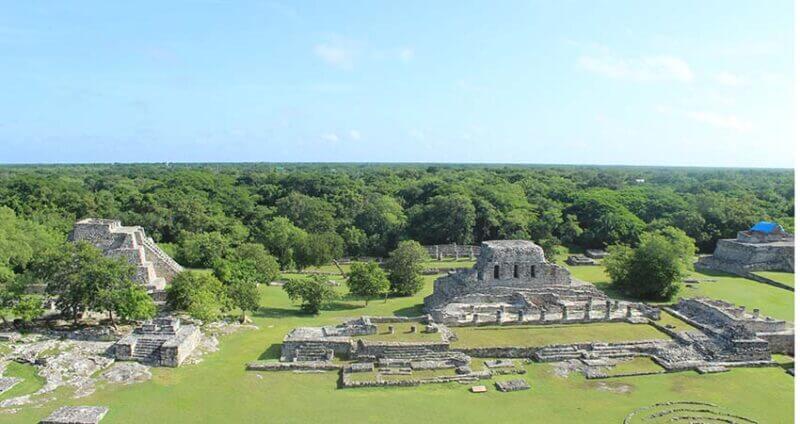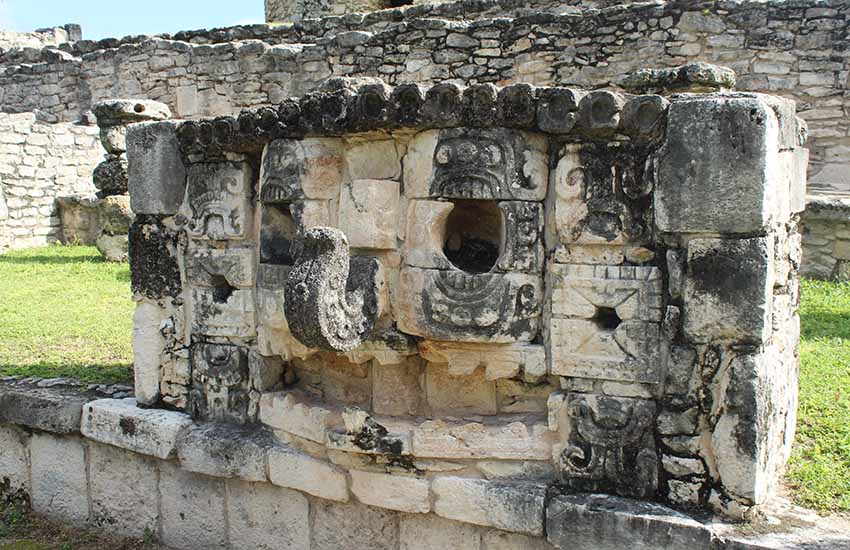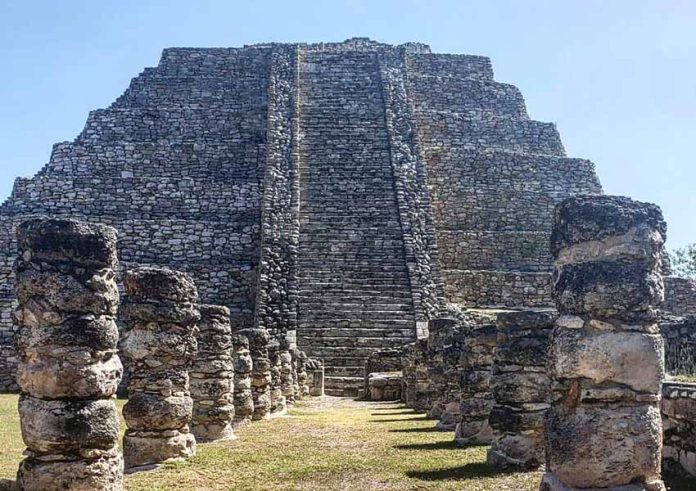Mayapán, considered the last prominent capital of the ancient Mayas, is ideal for visitors who prefer archaeological zones with fewer crowds.
Mayapán is believed to mean “banner of the Mayas” or “flag of the Mayas.” The site, about 40 kilometers from Mérida, Yucatán, in the municipality of Tecoh, was inhabited between 300 B.C.–A.D. 600, but the walled city is thought to have been established in the 13th century. It was an important Maya city during A.D. 1250–1450, when its population is estimated to have been around 12,000.
The Spanish bishop Fray Diego de Landa wrote around 1560 that local tradition named the founder of Mayapán as the Mayan lord Kukulcán, who is thought to have ruled here for a while before leaving for central Mexico.
Thereafter, Mayapán was ruled by the Cocomes, a wealthy family with the city’s oldest lineage.
According to the National Institute of Anthropology and History (INAH), the city rose to power after the prosperous eras of Chichén Itzá and Uxmal, although it is thought to have had a centralized government like in Chichén Itzá. It was abandoned after being destroyed and burned around the mid-15th century.

Mayapán extends over four square kilometers with around 4,000 structures, but the main area is small and easy to explore. The city’s surrounding wall has a circumference of over nine kilometers.
Perhaps not surprisingly, given its suspected connection to the more famous Maya city, Mayapán is thought to have been influenced by Chichén Itzá: its main pyramid, the Castle of Kukulcán, resembles the main pyramid of Chichén Itzá (El Castillo, which is also called the Pyramid of Kukulcán). However, Mayapán’s pyramid is smaller.
One enters the archaeological zone from the north. Climbing is allowed on most of the site’s buildings.
Near the entrance is the Temple of the Fisherman, with a stairway to the south. This temple holds a mural that is said to depict a scene of a person catching fish.
A beautiful structure in the north section of the site is the Temple of the Painted Niches. This temple has seven rooms, including one with a mural painting that is believed to depict the entrances of five temples and serpent heads with open jaws, over which the temples rest.
To the south, you’ll find the Central Plaza, where the governmental, administrative and religious structures, as well as the rulers’ residences, were located. South of the Central Plaza is the main pyramid, the most significant and tallest building of Mayapán — the aforementioned Castle of Kukulcán. A nine-level pyramid, it reaches 18 meters in height and sits on a base measuring 30 meters on each side.
There are remains of the temple that was built on top of this pyramid, and the main entrance’s columns were once decorated with serpent figures, according to INAH, which says they were similar to ones found at Chichén Itzá. While the climb to the top of this pyramid is steep, the views from the summit are stunning.
The southeastern side of the pyramid has a substructure with stucco reliefs of decapitated warriors. Due to the discovery of a jawbone and pieces of human skulls, the substructure is speculated to have been used for rituals, possibly of a death cult that covered human skulls with stucco.
To the east, adjoining the Castle of Kukulcán, is the Room of the Frescoes, named for the remains of murals discovered here. A scene includes two richly dressed individuals holding a circular banner that depicts sun symbols. Other features of this room include a bench and an altar.
To the southwest of the Plaza is the Room of the Kings, with many columns and a wall with a doorway. The name comes from the human heads sculpted of stucco discovered here, whose purpose is believed decorative.
Southeast of the Castle of Kukulcán, there is a sinkhole called the cenote Chen Mul. On its southern border, you’ll find the Temple of the Cenote Chen Mul.
The temple has three entrances, and its interior features include an altar. There is a platform with a drain that likely emptied rainwater into the cenote, and the temple also has a ramp with access to the Castle of Kukulcán. Near the cenote, the Room of the Masks of the God Chaac features an altar and a shrine and is thought to have been a place of religious and ritual activities. The upper section of the structure has masks of Chaac – the Maya god of rain.

East of the Central Plaza is a beautiful structure called the Round Temple — a round structure on a rectangular base, that is believed to have been a ceremonial building.
There is a wide stairway to access the building from the west, and the temple has four entrances. There is a cylinder-like structure in the center of the temple. The building also includes an altar and a shrine.
To the east of the plaza are other buildings worth seeing. A notable one is the Oratory, whose features include two altars in front and one inside, and a shrine by the stairway where 13 human skulls were discovered. Another building is a structure named Xbi Ac, meaning “Turtle-Man,” named after a turtle sculpture with a human head discovered here. There are altars in this building as well.
Northeast of the Central Plaza, you’ll see the Warriors Temple, thought to be ceremonial in purpose. Built on a two-level base, it has an altar inside. Serpent heads and dice adorn the top of the panels by the stairway.
North of the plaza is the Temple of the Mask with six small altars. It’s named after a stucco head discovered here. Adjoining it is the Shrine of the Skulls, named after the human skulls found here. In this section, a structure called the Turtle’s Room, featuring an altar, is worth seeing. Stone turtle figures thought to have been offerings were discovered here.
There are several other structures to explore, including the Temple of the Crematorium, speculated to be ceremonial in purpose.
The winter solstice is a good time to visit Mayapán, when a light and shadow effect in the shape of a serpent occurs on the Castle of Kukulcán like the famed effect at Chichén Itzá. Meanwhile, a different astronomical phenomenon involving halo-like light effects can also be observed during the winter solstice in the Round Temple.
Thilini Wijesinhe, a financial professional turned writer and entrepreneur, moved to Mexico in 2019 from Australia. She writes from Mérida, Yucatán. Her website can be found at https://momentsing.com/
